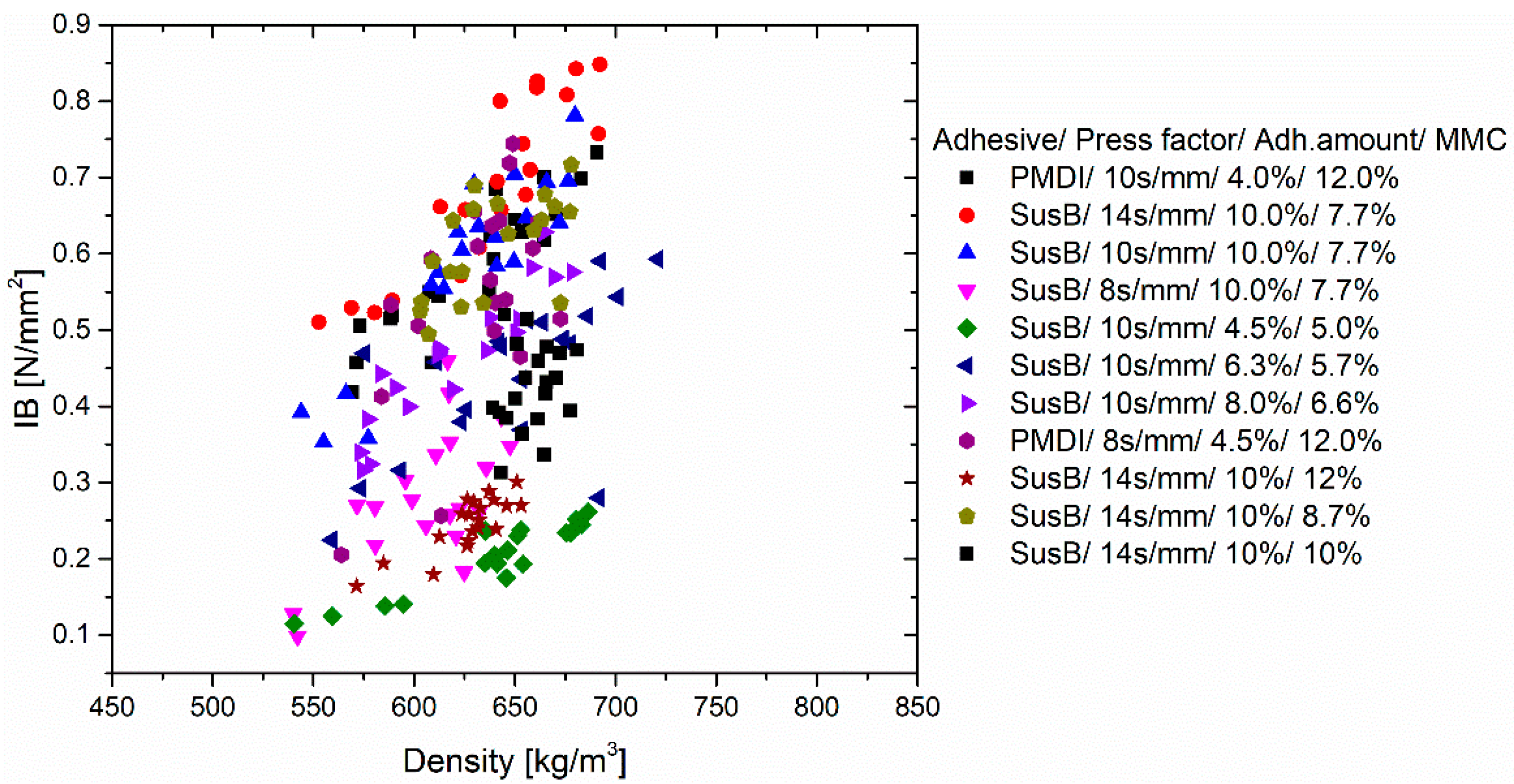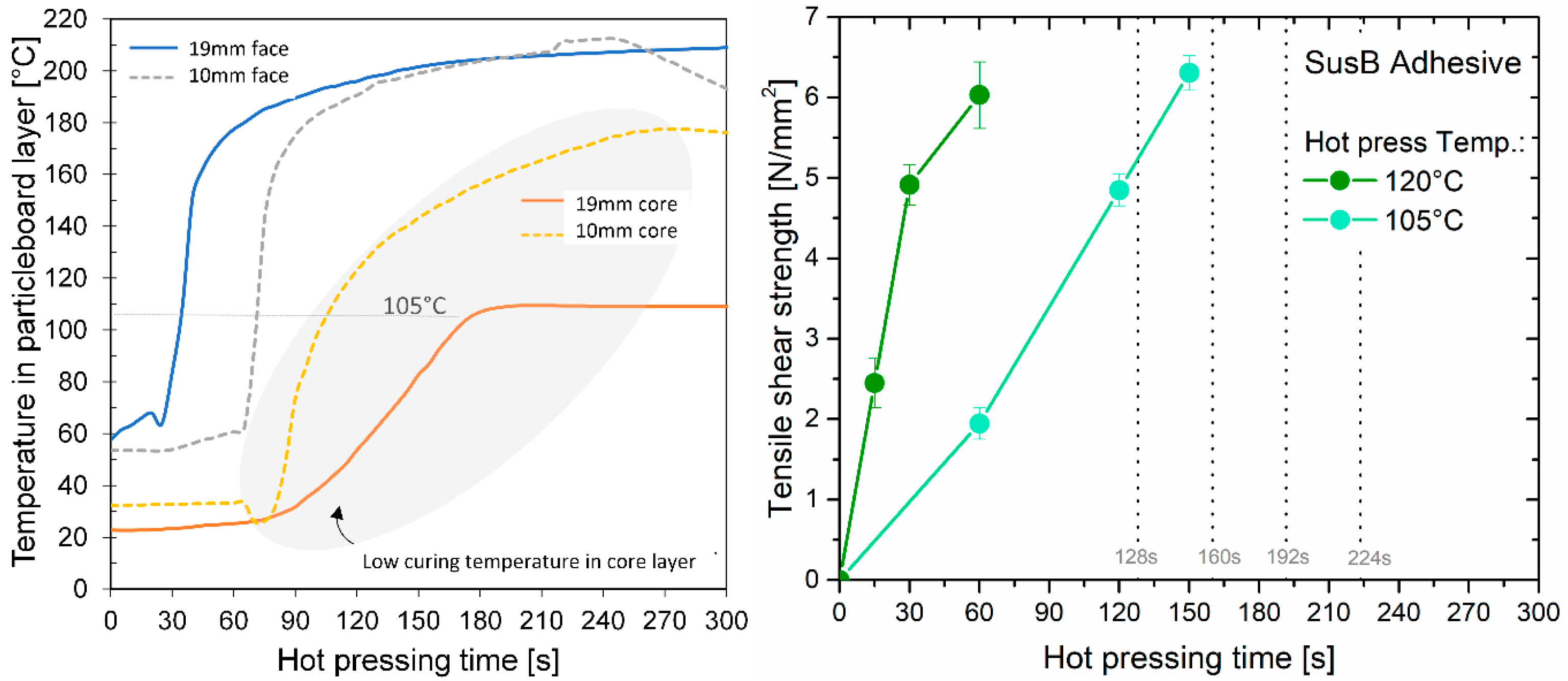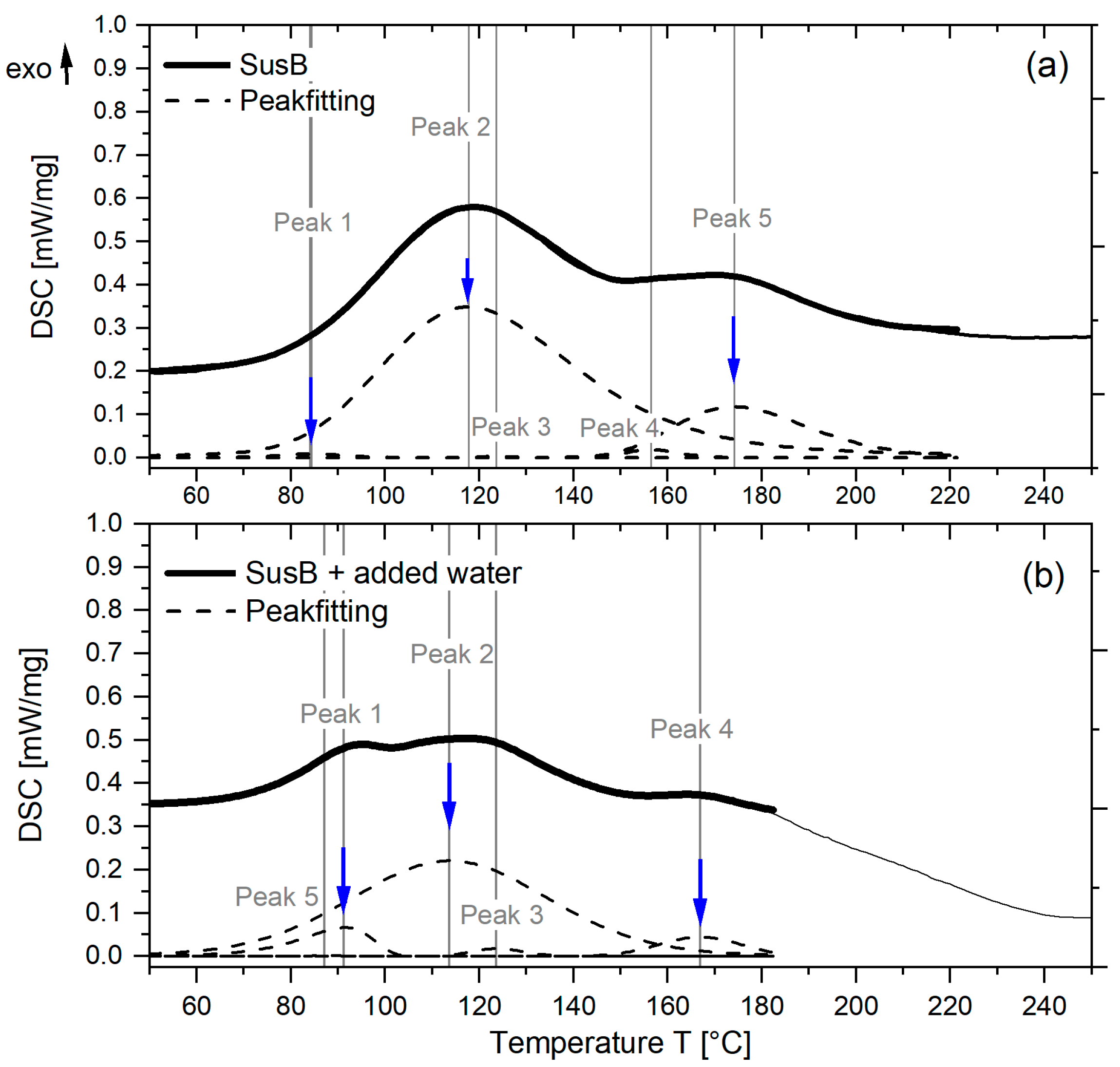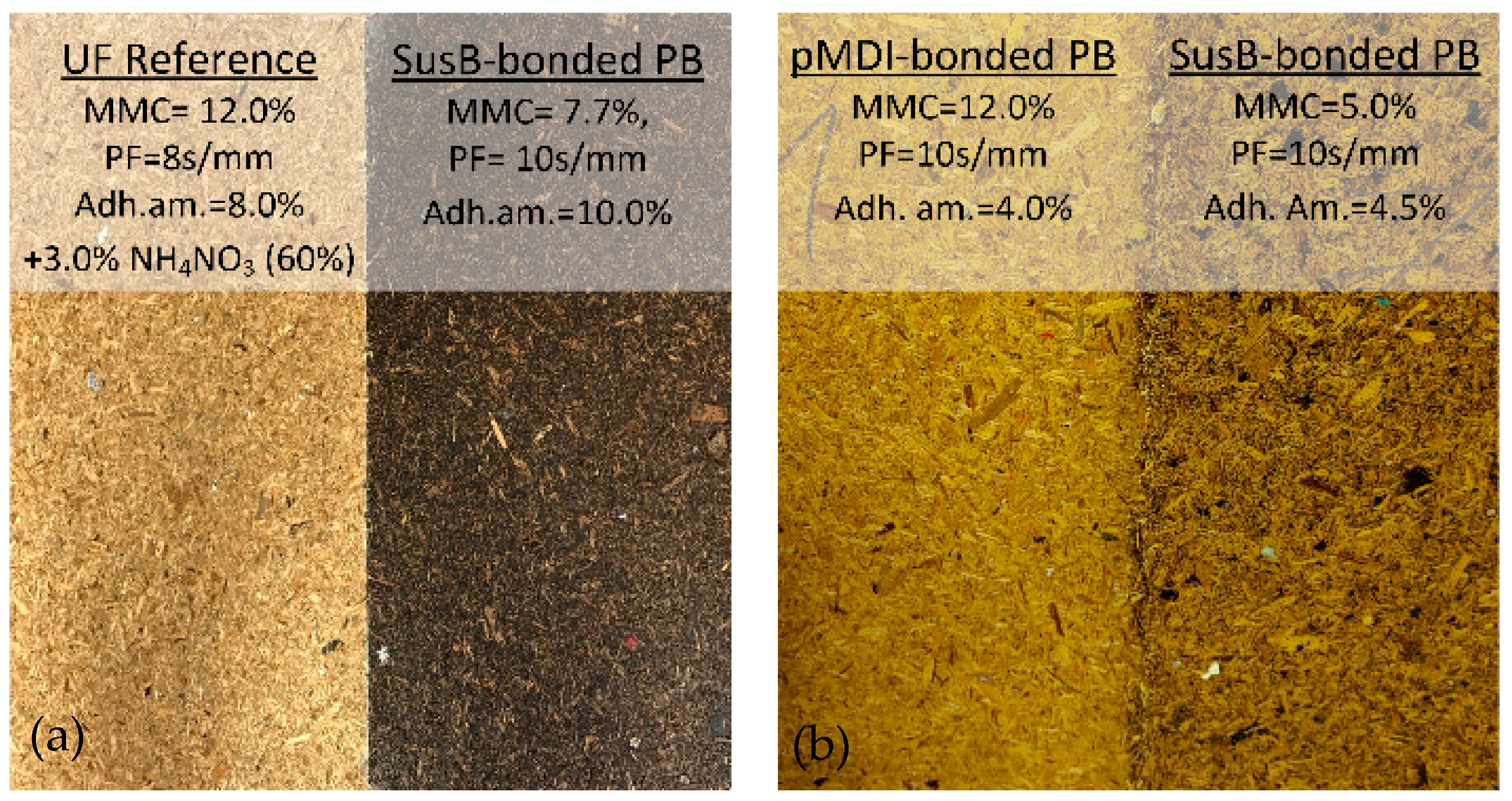Effect of Mat Moisture Content, Adhesive Amount and Press Time on the Performance of Particleboards Bonded with Fructose-Based Adhesives
Abstract
:1. Introduction
2. Materials and Methods
2.1. Raw Materials
2.2. Adhesive Synthesis
2.3. Tensile Shear Strength (ABES)
2.4. Thermal Analysis
2.5. Particleboard Production
2.6. Particleboard Testing
2.6.1. Board Density
2.6.2. Internal bond Strength
2.6.3. Thickness Swelling
2.6.4. Statistical Evaluation
3. Results and Discussion
3.1. Statistical Evaluation
- SusB/14 s/mm/10%/10% and SusB/10 s/mm/8.0%/6.6%
- SusB/14 s/mm/10%/10% and SusB/8 s/mm/10.0%/7.7%
- SusB/8 s/mm/10%/7.7% and SusB/10 s/mm/6.3%/5.7%
3.2. Adhesive Performance
3.2.1. Cure Temperature
3.2.2. Cure Reactions
3.3. Particleboard Test Results
3.3.1. Variation of Mat Moisture Content
3.3.2. Variation of Press Time
3.3.3. Variation of Adhesive Amount
3.3.4. Thickness Swelling and Water Absorption
4. Conclusions
Supplementary Materials
Author Contributions
Funding
Institutional Review Board Statement
Informed Consent Statement
Conflicts of Interest
References
- Pędzik, M.; Auriga, R.; Kristak, L.; Antov, P.; Rogoziński, T. Physical and Mechanical Properties of Particleboard Produced with Addition of Walnut (Juglans regia L.) Wood Residues. Materials 2022, 15, 1280. [Google Scholar] [CrossRef] [PubMed]
- European Panel Federation. Types of Wood-Based Panels and Their Economic Impact/Particleboard. Available online: https://europanels.org/the-wood-based-panel-industry/types-of-wood-based-panels-economic-impact/particleboard/ (accessed on 7 October 2022).
- Arias, A.; González-Rodríguez, S.; Vetroni Barros, M.; Salvador, R.; de Francisco, A.C.; Moro Piekarski, C.; Moreira, M.T. Recent developments in bio-based adhesives from renewable natural resources. J. Clean. Prod. 2021, 314, 127892. [Google Scholar] [CrossRef]
- Popović, M.; Điporović-Momčilović, M.; Gavrilović-Grmuša, I. New standards and regulations on formaldehyde emission from wood-based composite panels. Zast. Mater. 2020, 61, 152–160. [Google Scholar] [CrossRef]
- Que, Z.; Furuno, T.; Katoh, S.; Nishino, Y. Effects of urea–formaldehyde resin mole ratio on the properties of particleboard. Build. Environ. 2007, 42, 1257–1263. [Google Scholar] [CrossRef]
- Myers, G.E. How mole ratio of UF resin affects formaldehyde emission and other properties: A literature critique. For. Prod. J. 1984, 34, 35–41. [Google Scholar]
- Gonçalves, D.; Bordado, J.M.; Marques, A.C.; Galhano Dos Santos, R. Non-Formaldehyde, Bio-Based Adhesives for Use in Wood-Based Panel Manufacturing Industry-A Review. Polymers 2021, 13, 4086. [Google Scholar] [CrossRef]
- European Commission. Commission Regulation (EU) No 605/2014 of 5 June 2014 amending, for the purposes of introducing hazard and precautionary statements in the English language and its adaptation to technical and scientific progress, Regulation (EC) No 1272/2008 of the European Parliament and of the Council on classification, labelling and packaging of substances and mixtures. OJ L 2014, 167, 36–49. [Google Scholar]
- Solt, P.; Konnerth, J.; Gindl-Altmutter, W.; Kantner, W.; Moser, J.; Mitter, R.; van Herwijnen, H.W.G. Technological performance of formaldehyde-free adhesive alternatives for particleboard industry. Int. J. Adhes. Adhes. 2019, 94, 99–131. [Google Scholar] [CrossRef]
- Papadopoulos, A.N.; Hill, C.A.S.; Traboulay, E.; Hague, J.R.B. Isocyanate Resins for Particleboard: PMDI vs. EMDI. Holz Als Roh- Und Werkst. 2002, 60, 81–83. [Google Scholar] [CrossRef]
- Mantanis, G.I.; Athanassiadou, E.T.; Barbu, M.C.; Wijnendaele, K. Adhesive systems used in the European particleboard, MDF and OSB industries. Wood Mater. Sci. Eng. 2018, 13, 104–116. [Google Scholar] [CrossRef]
- Kelly, M.W. Critical Literature Review of Relationships Between Processing Parameters and Physical Properties of Particleboard; U.S. Department of Agriculture, Forest Service, Forest Products Laboratory: Washington, DC, USA, 1977.
- Pizzi, A.P. Synthetic Adhesives for Wood Panels: Chemistry and Technology. In Progress in Adhesion and Adhesives; Mittal, K.L., Ed.; Scrivener Publishing LLC: Beverly, MA, USA, 2015; pp. 85–123. [Google Scholar] [CrossRef]
- Salem, M.; Böhm, M. Understanding of Formaldehyde Emissions from Solid Wood: An Overview. Bioresources 2013, 8, 4775–4790. [Google Scholar] [CrossRef]
- Head, M.; Levasseur, A.; Beauregard, R.; Margni, M. Dynamic greenhouse gas life cycle inventory and impact profiles of wood used in Canadian buildings. Build. Environ. 2020, 173, 106751. [Google Scholar] [CrossRef]
- Heinrich, L.A. Future opportunities for bio-based adhesives—Advantages beyond renewability. Green Chem. 2019, 21, 1866–1888. [Google Scholar] [CrossRef] [Green Version]
- Antov, P.; Savov, V.; Neykov, N. Sustainable bio-based adhesives for eco-friendly wood composites—A review. Wood Res. 2020, 65, 51–62. [Google Scholar] [CrossRef]
- Wang, K.; Gao, S.; Lai, C.; Xie, Y.; Sun, Y.; Wang, J.; Wang, C.; Yong, Q.; Chu, F.; Zhang, D. Upgrading wood biorefinery: An integration strategy for sugar production and reactive lignin preparation. Ind. Crops Prod. 2022, 187, 115366. [Google Scholar] [CrossRef]
- Karthäuser, J.; Biziks, V.; Mai, C.; Militz, H. Lignin and Lignin-Derived Compounds for Wood Applications-A Review. Molecules 2021, 26, 2533. [Google Scholar] [CrossRef]
- Arias, A.; González-García, S.; Feijoo, G.; Moreira, M.T. Tannin-based bio-adhesives for the wood panel industry as sustainable alternatives to petrochemical resins. J. Ind. Ecol. 2022, 26, 627–642. [Google Scholar] [CrossRef]
- Dhawale, P.V.; Vineeth, S.K.; Gadhave, R.V.; Fatima, M.J.J.; Supekar, M.V.; Thakur, V.K.; Raghavan, P. Tannin as a renewable raw material for adhesive applications: A review. Mater. Adv. 2022, 3, 3365–3388. [Google Scholar] [CrossRef]
- Averina, E.; Konnerth, J.; van Herwijnen, H.W.G. Protein Adhesives: Investigation of Factors Affecting Wet Strength of Alkaline Treated Proteins Crosslinked with Glyoxal. Polymers 2022, 14, 4351. [Google Scholar] [CrossRef]
- Raydan, N.D.V.; Leroyer, L.; Charrier, B.; Robles, E. Recent Advances on the Development of Protein-Based Adhesives for Wood Composite Materials-A Review. Molecules 2021, 26, 7671. [Google Scholar] [CrossRef]
- Maulana, M.I.; Lubis, M.A.R.; Febrianto, F.; Hua, L.S.; Iswanto, A.H.; Antov, P.; Kristak, L.; Mardawati, E.; Sari, R.K.; Zaini, L.H.; et al. Environmentally Friendly Starch-Based Adhesives for Bonding High-Performance Wood Composites: A Review. Forests 2022, 13, 1614. [Google Scholar] [CrossRef]
- Jimenez Bartolome, M.; Padhi, S.S.P.; Fichtberger, O.G.; Schwaiger, N.; Seidl, B.; Kozich, M.; Nyanhongo, G.S.; Guebitz, G.M. Improving Properties of Starch-Based Adhesives with Carboxylic Acids and Enzymatically Polymerized Lignosulfonates. Int. J. Mol. Sci. 2022, 23, 13547. [Google Scholar] [CrossRef] [PubMed]
- Zhang, H.; Liu, P.; Musa, S.M.; Mai, C.; Zhang, K. Dialdehyde Cellulose as a Bio-Based Robust Adhesive for Wood Bonding. ACS Sustain. Chem. Eng. 2019, 7, 10452–10459. [Google Scholar] [CrossRef]
- Dunky, M. Wood Adhesives Based on Natural Resources: A Critical Review: Part II. Carbohydrate-Based Adhesives. In Progress in Adhesion and Adhesives; Wiley: Chichester, UK, 2021; pp. 337–382. [Google Scholar] [CrossRef]
- Akinterinwa, A.; Ismaila, A.; Aliyu, B. Concise Chemistry of Urea Formaldehyde Resins and Formaldehyde Emission. Ins. Org. Inorg. 2020, 1. [Google Scholar] [CrossRef]
- Pellis, A.; Malinconico, M.; Guarneri, A.; Gardossi, L. Renewable polymers and plastics: Performance beyond the green. New Biotechnol. 2021, 60, 146–158. [Google Scholar] [CrossRef]
- Rosenfeld, C.; Sailer-Kronlachner, W.; Konnerth, J.; Sol-Rindler, P.; Pellis, A.; Rosenau, T.; Potthast, A.; van Herwijnen, H.W.G. Hydroxymethylfurfural: A key to increased reactivity and performance of fructose-based adhesives for particle boards. Ind. Crops Prod. 2022, 187, 115536. [Google Scholar] [CrossRef]
- EN 312:2003; European Standard. EN312 Particleboards-Specifications. European Committee for Standardization: Brussels, Belgium, 2010.
- Sailer-Kronlachner, W.; Rosenfeld, C.; Böhmdorfer, S.; Bacher, M.; Konnerth, J.; Rosenau, T.; Potthast, A.; van Herwijnen, H.W.G. Scale-up of 5-Hydroxymethylfurfural rich adhesive precursor production and structural features of humin side products. Biomass Conv. Bioref. 2022, 1–18. [Google Scholar] [CrossRef]
- Humphrey, P.E. Device for Testing Adhesive Bonds. U.S. Patent 005176028, 5 January 1993. [Google Scholar]
- ASTM D7998-15; Standard Test Method for Measuring the Effect of Temperature on the Cohesive Strength Development of Adhesives Using Lap Shear Bonds under Tensile Loading. ASTM International: West Conshohocken, PA, USA, 2015. [CrossRef]
- DIN EN319; Particleboards and Fibreboards—Determination of Tensile Strength Perpendicular to Plane of the Board. European Committee for Standardization: Brussels, Belgium, 1993.
- EN317; Particleboards and Fibreboards; Determination of Swelling in Thickness after Immersion in Water. European Committee for Standardization: Brussels, Belgium, 2005.
- Ferreira, A.M.; Pereira, J.; Almeida, M.; Ferra, J.; Paiva, N.; Martins, J.; Magalhães, F.D.; Carvalho, L.H. Low-cost natural binder for particleboards production: Study of manufacture conditions and stability. Int. J. Adhes. Adhes. 2019, 93, 102325. [Google Scholar] [CrossRef]
- Maku, T.; Hamada, R.; Sasaki, H. Studies on the Particle Board: Report 4; Temperature and Moisture Distribution in Particle Board during Hot-Pressing; Wood Research Institute of Kyoto University: Uji, Japan, 1959; Volume 21, pp. 34–46. [Google Scholar]
- Gaff, M.; Ruman, D.; Gašparík, M.; Štícha, V.; Boška, P. Tensile-Shear Strength of Glued Line of Laminated Veneer Lumber. Bioresources 2016, 11, 1382–1392. [Google Scholar] [CrossRef]
- Papadopoulos, A. Property comparisons and bonding efficiency of UF and PMDI bonded particleboards as affected by key process variables. BioResources 2006, 1, 201–208. [Google Scholar] [CrossRef]
- Martins, S.I.F.S.; Jongen, W.M.F.; van Boekel, M.A.J.S. A review of Maillard reaction in food and implications to kinetic modelling. Trends Food Sci. Technol. 2000, 11, 364–373. [Google Scholar] [CrossRef]
- He, G.; Yan, N. Effect of moisture content on curing kinetics of pMDI resin and wood mixtures. Int. J. Adhes. Adhes. 2005, 25, 450–455. [Google Scholar] [CrossRef]
- Wibowo, E.S.; Park, B.-D.; Causin, V. Recent advances in urea–formaldehyde resins: Converting crystalline thermosetting polymers back to amorphous ones. Polym. Rev. 2022, 62, 722–756. [Google Scholar] [CrossRef]
- Cai, Z.; Muehl, J.; Winandy, J. Effects of panel density and mat moisture content on processing medium density fiberboard. For. Prod. J. 2006, 56, 20–25. [Google Scholar]
- Ayrilmis, N.; Kwon, J.H.; Han, T.H. Effect of resin type and content on properties of composite particleboard made of a mixture of wood and rice husk. Int. J. Adhes. Adhes. 2012, 38, 79–83. [Google Scholar] [CrossRef]
- Benthien, J.T.; Ohlmeyer, M.; Schneider, M.; Stehle, T. Experimental determination of the compression resistance of differently shaped wood particles as influencing parameter on wood-reduced particleboard manufacturing. Eur. J. Wood Wood Prod. 2018, 76, 937–945. [Google Scholar] [CrossRef]






| Adhesive | pMDI Reference | SusB | SusB | SusB |
|---|---|---|---|---|
| Amount of adhesive (on dry base) [%] | 4.5 | 10 | 10 | 10 |
| Moisture content of wood particles [%] | 3.0 | 3.0 | 3.0 | 3.0 |
| Added water based on dry wood [wt.%] | 11.2 | 4.6 | 1.8 | 0.0 |
| Resulting initial mat moisture content [wt.%] | 12.0 | 12.0 | 10.0 | 8.7 |
| Press factor [s/mm] | 8 | 14 | 14 | 14 |
| Adhesive | pMDI Reference | SusB | SusB | SusB | SusB | SusB | SusB |
|---|---|---|---|---|---|---|---|
| Amount of adhesive [%] | 4 | 10 | 10 | 10 | 4.5 | 6.3 | 8.0 |
| Moisture content of wood particles [%] | 1.8 | 1.8 | 1.8 | 1.8 | 1.8 | 1.8 | 1.8 |
| Mat moisture content (MMC) [wt.%] | 12.0 | 7.7 | 7.7 | 7.7 | 5.0 | 5.7 | 6.6 |
| Added water based on dry wood [wt.%] | 12.4 | 0.0 | 0.0 | 0.0 | 0.0 | 0.0 | 0.0 |
| Press factor [s/mm] | 10 | 14 | 10 | 8 | 10 | 10 | 10 |
| SusB Adhesive | |||
| Peak [-] | Onset Temperature [°C] | Peak Temperature [°C] | Enthalpy [J/g] |
| 1 | 70.7 | 84.3 | 2.66 |
| 2 | 82.7 | 117.7 | 371.88 |
| 3 | 118.3 | 123.6 | 2.66 |
| 4 | 145.0 | 156.5 | 5.46 |
| 5 | 149.5 | 174.1 | 82.34 |
| SusB Adhesive + Added Water | |||
| Peak [-] | Onset Temperature [°C] | Peak Temperature [°C] | Enthalpy [J/g] |
| 1 | 73.0 | 91.3 | 33.74 |
| 2 | 74.7 | 113.7 | 270.46 |
| 3 | 113.0 | 123.6 | 6.61 |
| 4 | 149.2 | 166.9 | 8.70 |
| 5 | 82.5 | 87.1 | 0.38 |
Publisher’s Note: MDPI stays neutral with regard to jurisdictional claims in published maps and institutional affiliations. |
© 2022 by the authors. Licensee MDPI, Basel, Switzerland. This article is an open access article distributed under the terms and conditions of the Creative Commons Attribution (CC BY) license (https://creativecommons.org/licenses/by/4.0/).
Share and Cite
Rosenfeld, C.; Solt-Rindler, P.; Sailer-Kronlachner, W.; Kuncinger, T.; Konnerth, J.; Geyer, A.; van Herwijnen, H.W.G. Effect of Mat Moisture Content, Adhesive Amount and Press Time on the Performance of Particleboards Bonded with Fructose-Based Adhesives. Materials 2022, 15, 8701. https://doi.org/10.3390/ma15238701
Rosenfeld C, Solt-Rindler P, Sailer-Kronlachner W, Kuncinger T, Konnerth J, Geyer A, van Herwijnen HWG. Effect of Mat Moisture Content, Adhesive Amount and Press Time on the Performance of Particleboards Bonded with Fructose-Based Adhesives. Materials. 2022; 15(23):8701. https://doi.org/10.3390/ma15238701
Chicago/Turabian StyleRosenfeld, Catherine, Pia Solt-Rindler, Wilfried Sailer-Kronlachner, Thomas Kuncinger, Johannes Konnerth, Andreas Geyer, and Hendrikus W. G. van Herwijnen. 2022. "Effect of Mat Moisture Content, Adhesive Amount and Press Time on the Performance of Particleboards Bonded with Fructose-Based Adhesives" Materials 15, no. 23: 8701. https://doi.org/10.3390/ma15238701






